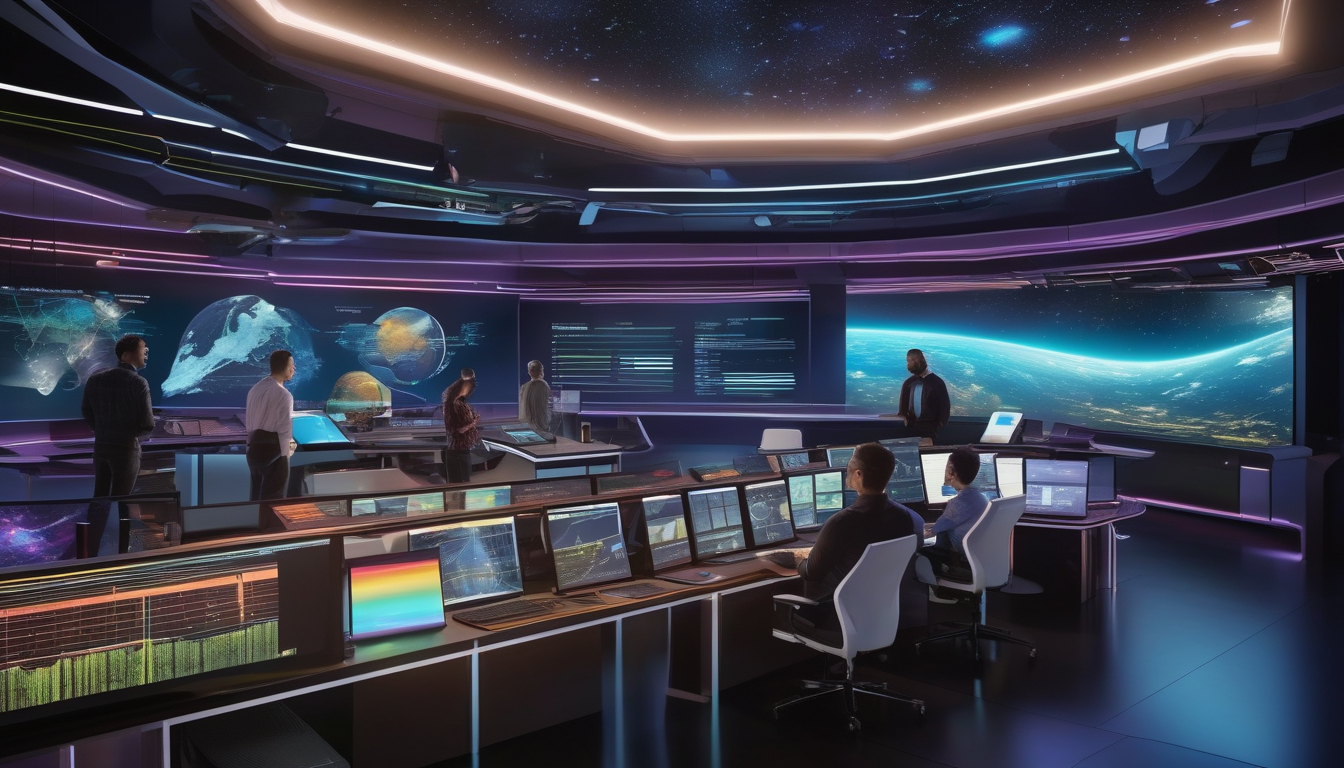As we stand on the brink of a new era in space exploration, the role of artificial intelligence (AI) is becoming increasingly pivotal. Imagine a future where spacecraft can navigate the cosmos without human intervention, making split-second decisions while dodging space debris and optimizing their paths. This is not just science fiction; it’s happening right now! AI is transforming our approach to exploring the final frontier, and the possibilities are truly exciting.
From AI-powered navigation systems that enhance safety and efficiency to advanced data analysis techniques that help scientists make sense of the vast amounts of information collected during missions, AI is paving the way for groundbreaking discoveries. The integration of machine learning in astrobiology is particularly thrilling, as it allows researchers to sift through complex datasets to identify potential signs of life on distant planets. This capability is akin to finding a needle in a haystack, but with AI, the search becomes more manageable and efficient.
Moreover, AI-driven predictive modeling is revolutionizing how we plan and execute planetary exploration missions. By forecasting planetary conditions, mission planners can design strategies that maximize the chances of success while optimizing resource allocation. Picture this: a team of scientists can now predict weather patterns on Mars, allowing them to choose the best times for exploration. This level of foresight is invaluable for long-duration missions where every decision counts.
The synergy between AI and robotic systems is another area ripe with potential. Robots equipped with AI can autonomously collect and analyze samples, reducing the need for constant human oversight. This not only enhances operational efficiency but also allows astronauts to focus on more complex tasks. As we venture deeper into space, the ability of AI to enhance communication systems will ensure that data transmission remains reliable, even in the most challenging environments.
In conclusion, the future of AI in space exploration is bright and full of promise. As we continue to push boundaries, the collaboration between humans and AI will redefine our understanding of the universe. However, as we embrace these advancements, we must also consider the ethical implications of AI deployment in space. The journey ahead is filled with opportunities, and it’s one we cannot afford to miss!

AI-Powered Navigation Systems
Artificial intelligence is not just a buzzword; it’s a game-changer in the realm of space exploration, particularly when it comes to navigation systems. Imagine a spacecraft that can think on its feet, making real-time decisions without waiting for instructions from Earth. This revolutionary capability enhances both efficiency and safety during missions, allowing for a more autonomous approach to navigating the vastness of space.
Traditional navigation systems often rely on constant human oversight, which can lead to delays and potential errors. However, with AI-powered systems, spacecraft can analyze their surroundings, assess risks, and adjust their trajectories instantaneously. This means that missions can adapt to unforeseen challenges, such as avoiding space debris or recalibrating paths due to unexpected gravitational pulls. The integration of AI not only streamlines these processes but also reduces the cognitive load on mission control teams.
To illustrate the impact of AI in navigation, consider the following advantages:
- Increased Autonomy: Spacecraft can operate independently, making decisions based on real-time data.
- Enhanced Safety: AI systems can predict potential hazards and take preventive measures.
- Optimized Routes: AI can calculate the most efficient paths, saving time and fuel.
As we look to the future, the potential for AI in navigation systems is staggering. With advancements in machine learning and data processing, we can expect even more sophisticated algorithms that can learn from past missions and improve future navigation strategies. The synergy between AI and autonomous navigation systems not only propels us further into the cosmos but also opens doors to new discoveries that were once thought impossible.

Data Analysis and Interpretation
The vast amounts of data collected during space missions can be overwhelming. With each launch, spacecraft generate terabytes of information, from atmospheric readings to surface compositions. This is where artificial intelligence (AI) steps in, acting like a skilled librarian in a chaotic library, sifting through countless books to find the ones that matter. AI algorithms streamline data processing, allowing scientists to analyze and interpret complex datasets more effectively. Imagine trying to find a needle in a haystack; AI turns that haystack into a neatly organized toolbox, making discoveries not just quicker but also more insightful.
One of the most exciting aspects of AI in data analysis is its ability to uncover patterns that might go unnoticed by human eyes. For instance, AI can identify subtle changes in data trends that could indicate the presence of water or even signs of life on other planets. This capability is crucial as we venture into the unknown, where every bit of information can be a clue to understanding our universe.
Furthermore, AI enhances collaboration among scientists. By providing real-time data interpretation, researchers can make informed decisions faster. This is especially important during missions where time is of the essence. Picture a team of astronauts on Mars, working against the clock; AI can help them prioritize tasks based on the latest data, ensuring they focus on what truly matters.
To illustrate the impact of AI on data analysis, consider the following table:
| AI Application | Benefit |
|---|---|
| Pattern Recognition | Identifies anomalies in data sets that may indicate life signs. |
| Real-Time Analysis | Allows for immediate decision-making during missions. |
| Data Visualization | Transforms complex data into understandable formats. |
In conclusion, as we continue to explore the cosmos, the role of AI in data analysis and interpretation will only grow. It not only enhances our understanding of space but also accelerates the pace of discovery, bringing us closer to answering the age-old question: Are we alone in the universe?
Machine Learning in Astrobiology
When we think about the search for life beyond our planet, machine learning emerges as a powerful ally in the field of astrobiology. Imagine sifting through mountains of data collected from distant planets and moons; it’s like searching for a needle in a haystack. That’s where AI comes into play! With its ability to analyze and identify patterns in vast datasets, machine learning is revolutionizing how scientists look for signs of extraterrestrial life.
One of the most exciting applications of machine learning in astrobiology is its role in analyzing atmospheric conditions and surface compositions. By employing algorithms that learn from previous data, scientists can predict which planets might harbor life. For instance, machine learning can help in identifying specific chemical signatures in the atmosphere that indicate the presence of life, such as methane or oxygen. These indicators are crucial because they can suggest biological processes occurring on those planets.
Furthermore, consider the sheer volume of data that space missions generate. For example, the Kepler Space Telescope alone has collected data on over 150,000 stars, searching for planets in the habitable zone. Analyzing this data manually would take years, if not decades. However, with machine learning, we can process this information in a fraction of the time, allowing for quicker and more efficient discoveries. This rapid analysis not only speeds up research but also enhances our understanding of the universe.
In summary, machine learning is not just a buzzword; it’s a transformative technology that is shaping the future of astrobiology. By enabling scientists to analyze complex datasets and identify potential signs of life, machine learning is paving the way for groundbreaking discoveries that could one day answer the age-old question: Are we alone in the universe?
Predictive Modeling for Planetary Exploration
Predictive modeling is rapidly becoming a cornerstone in the realm of planetary exploration, acting as a crystal ball for mission planners. Imagine being able to foresee the environmental conditions of distant planets before sending a spacecraft. That’s precisely what AI-driven predictive models do! They analyze vast datasets from previous missions, satellite imagery, and even simulations to forecast the dynamic conditions of celestial bodies.
These models utilize complex algorithms that can process numerous variables, including temperature fluctuations, atmospheric composition, and surface geology. By understanding these factors, scientists can devise more effective exploration strategies. For instance, if a model predicts a dust storm on Mars, mission planners can adjust their timelines or choose alternative landing sites to ensure the safety of their rovers.
Moreover, predictive modeling significantly enhances resource allocation. Long-duration missions require meticulous planning regarding fuel, food, and equipment. AI can simulate various scenarios, helping teams determine the optimal use of resources to maximize mission success. This is akin to playing a game of chess, where each move is calculated to outsmart potential challenges ahead.
In addition to improving safety and efficiency, predictive modeling also accelerates the pace of discovery. With the ability to anticipate conditions, scientists can quickly adapt their research focuses based on real-time data. For example, if a predictive model indicates potential water sources on a moon, researchers can prioritize those areas for exploration, leading to groundbreaking discoveries.
| Predictive Modeling Benefits | Impact on Missions |
|---|---|
| Enhanced Safety | Reduces risks by anticipating environmental hazards. |
| Resource Optimization | Improves planning for long-duration missions. |
| Accelerated Discoveries | Enables quicker adaptation to new findings. |
In conclusion, the integration of predictive modeling into planetary exploration is nothing short of revolutionary. By harnessing the power of AI, researchers are not just dreaming about the future of space exploration; they are actively shaping it. The stars are no longer out of reach—they are becoming our next frontier of understanding, thanks to the foresight that predictive modeling provides.
Robotic Systems and AI Integration
The integration of artificial intelligence into robotic systems is nothing short of a game-changer for space exploration. Imagine robots that can think, learn, and adapt in real-time, just like humans. This revolutionary capability allows these machines to perform complex tasks, such as sample collection and analysis, without requiring constant human oversight. With AI, robotic systems can autonomously navigate harsh extraterrestrial environments, making decisions based on the data they collect.
For instance, consider a scenario where a robot is deployed on Mars to analyze soil samples. Equipped with AI, it can assess the composition of the soil, determine its suitability for potential life, and even adjust its methods based on real-time findings. This level of autonomy not only enhances the efficiency of missions but also significantly reduces the risks associated with human intervention in hostile environments.
Moreover, AI integration facilitates better communication between multiple robotic systems. These robots can share data and insights, creating a network of information that enhances overall mission success. For example, if one robot discovers a promising geological feature, it can alert others to converge on that location, optimizing the exploration process.
However, the journey of integrating AI into robotic systems is not without challenges. There are technical hurdles to overcome, such as ensuring that these systems can operate under the extreme conditions of space. Additionally, there are ethical considerations regarding the level of autonomy these robots should have. Should a robot be allowed to make critical decisions on its own? The answers to these questions are still being explored as we advance further into the cosmos.
In summary, the integration of AI in robotic systems is paving the way for a new era in space exploration. By enabling robots to operate independently and intelligently, we are not only enhancing our capabilities but also expanding the horizons of what is possible in our quest to explore the universe.
Enhancing Communication Systems
In the vast expanse of space, communication is more than just a convenience; it’s a lifeline. As we send spacecraft hurtling into the unknown, the need for robust communication systems becomes evident. Artificial Intelligence is stepping up to the plate, transforming how we connect with our machines and gather data from the cosmos. Imagine trying to have a conversation in a crowded room filled with noise; this is akin to the challenges faced in space communication. AI helps to cut through that noise.
One of the most significant advancements is in signal processing. AI algorithms can analyze and optimize signals in real-time, ensuring that the data transmitted back to Earth is clear and accurate. This is especially crucial when communicating with spacecraft that are millions of miles away. Consider the following benefits:
- Error Correction: AI enhances error detection and correction protocols, minimizing data loss during transmission.
- Adaptive Bandwidth Management: AI can dynamically adjust bandwidth usage based on mission needs, optimizing data flow.
- Predictive Maintenance: AI systems can predict potential communication failures before they happen, allowing for preemptive measures.
Moreover, as we venture deeper into space, the distance between Earth and our spacecraft increases, leading to delays in communication. AI mitigates this issue by enabling autonomous decision-making onboard. This means that spacecraft can analyze situations and make decisions without waiting for instructions from Earth, which is crucial during time-sensitive operations.
In summary, AI is not just enhancing communication systems; it’s revolutionizing them. By improving signal processing, ensuring reliable data transmission, and enabling autonomous operations, AI is paving the way for more successful and efficient space missions. As we look to the stars, we can be confident that our communication systems are equipped to handle the challenges of the universe.

AI in Space Mission Planning
When it comes to space mission planning, artificial intelligence is like the ultimate co-pilot, revolutionizing how we approach the vast unknowns of the cosmos. Imagine trying to coordinate a complex dance with multiple partners, each with its own rhythm and timing. That’s what mission planners face when orchestrating space missions. Thankfully, AI steps in to streamline the process, automating intricate scheduling tasks and resource management.
By leveraging advanced algorithms, AI can analyze numerous variables simultaneously, helping to optimize mission parameters. This not only enhances the success rates of missions but also significantly reduces costs. For instance, AI can predict potential risks and provide contingency plans, allowing teams to focus on the exciting aspects of exploration rather than getting bogged down by logistics.
One of the standout features of AI in mission planning is its ability to process vast amounts of data quickly. Consider the sheer volume of information that needs to be considered: spacecraft capabilities, crew requirements, environmental conditions, and much more. AI can sift through all this data and present the most viable options in real-time, making the decision-making process more efficient and informed.
Additionally, AI tools are designed to adapt and learn from past missions. This means that with each new expedition, the AI becomes more adept at predicting outcomes and improving planning strategies. For example, AI can analyze previous mission data to identify patterns that might affect future missions, leading to better resource allocation and time management.
In summary, the integration of AI into space mission planning is not just a trend; it’s a game-changer. As we venture further into the universe, AI will continue to play a pivotal role in ensuring that our missions are not only successful but also safe and cost-effective. The future of space exploration is bright, and with AI at the helm, the possibilities are truly endless.
Collaboration with Human Astronauts
In the vast expanse of space, the partnership between artificial intelligence (AI) and human astronauts is becoming increasingly vital. Imagine a scenario where a human astronaut is navigating the complexities of a distant planet, and beside them is an AI system that acts like a trusty sidekick, ready to assist at a moment’s notice. This collaboration is not just about sharing tasks; it’s about enhancing the overall mission experience and safety.
AI systems are designed to support astronauts in various ways, making their jobs easier and more efficient. For instance, these systems can analyze data in real-time, providing astronauts with crucial information that can affect their decisions. Think of it as having a personal assistant that can sift through mountains of data, highlighting what’s important, and alerting them to potential dangers. This not only optimizes performance but also ensures that astronauts can focus on the more intricate aspects of their missions.
Moreover, the synergy between humans and AI can lead to improved decision-making processes. During high-stress situations, the ability of AI to quickly process information can be a game-changer. For example, if an astronaut encounters an unexpected obstacle, the AI can instantly evaluate the situation, suggest possible solutions, and even simulate outcomes based on different choices. This dynamic interaction can significantly enhance mission success rates.
However, it’s essential to recognize that with great power comes great responsibility. As we integrate AI into space missions, we must consider the ethical implications of this collaboration. Questions about decision-making autonomy arise: How much control should humans retain over AI systems? What happens if an AI makes a critical error? Addressing these questions will be crucial as we venture further into the cosmos.
In summary, the collaboration between AI and human astronauts represents a revolutionary step in space exploration. With AI as a reliable partner, astronauts can navigate the unknown with greater confidence, making space travel safer and more efficient than ever before.
Ethical Considerations in AI Deployment
The integration of artificial intelligence in space exploration isn’t just about enhancing technology; it brings a plethora of ethical considerations that we must address. As AI systems take on more responsibilities, questions arise about their decision-making capabilities and the implications for human oversight. Are we ready to trust machines with critical decisions that could impact lives and missions? This question looms large as we navigate the uncharted waters of AI deployment in space.
One of the primary concerns is the issue of autonomy. When AI systems operate independently, they can make choices without human intervention, which raises the specter of accountability. If an autonomous spacecraft makes a poor decision, who is responsible? This dilemma necessitates a clear framework for understanding the limits of AI autonomy and the roles humans must retain in these missions. Additionally, the potential for bias in AI algorithms must not be overlooked. If the data fed into these systems is flawed or biased, the outcomes could lead to misleading conclusions about extraterrestrial conditions or even the existence of life.
Moreover, the deployment of AI technologies in space exploration also brings forth concerns related to data privacy. As AI systems collect and analyze vast amounts of data, ensuring that sensitive information is protected becomes crucial. The implications of data misuse or breaches could have far-reaching consequences, not just for the missions but also for the individuals involved.
Lastly, we must consider the impact of AI on the roles of human astronauts. While AI can enhance decision-making and operational efficiency, it could also lead to a diminished role for humans in space exploration. This raises an important question: how do we balance the benefits of AI with the need for human involvement in these groundbreaking endeavors?
In conclusion, the ethical landscape surrounding AI in space exploration is complex and multifaceted. As we continue to push the boundaries of what is possible, we must remain vigilant and proactive in addressing these ethical challenges to ensure that our journey into the cosmos is not only technologically advanced but also ethically sound.
Frequently Asked Questions
- How is AI changing navigation in space exploration?
AI is transforming navigation by enabling autonomous spacecraft to make real-time decisions. This means that these spacecraft can adapt to unexpected conditions without relying solely on human input, enhancing both safety and efficiency during missions.
- What role does AI play in data analysis from space missions?
AI algorithms help process the vast amounts of data collected during space missions. They streamline the analysis and interpretation of complex datasets, allowing scientists to make quicker discoveries and gain insights into the universe.
- Can AI help in finding signs of life on other planets?
Absolutely! Machine learning techniques are being used to analyze atmospheric conditions and surface compositions of other planets. This helps scientists identify potential signs of life, enhancing our understanding of extraterrestrial environments.
- How does AI assist in mission planning for space exploration?
AI technologies automate complex scheduling tasks, manage resources, and assess risks during mission planning. This not only enhances mission success rates but also helps reduce costs, making space exploration more efficient.
- What are the ethical considerations of using AI in space?
As AI becomes more integrated into space exploration, ethical concerns arise regarding decision-making autonomy, data privacy, and the potential impact on human roles in space missions. It’s crucial to address these issues to ensure responsible AI deployment.



